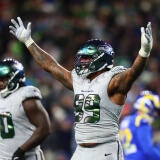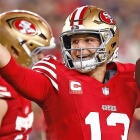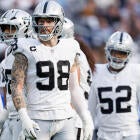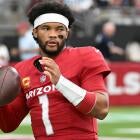2014 NFL Draft: What comes next for clubs after combine?
Players moving up, second-round gems and making sense of draft vs. free agency are all tasks facing NFL clubs after the scouting combine.
More Draft: NFL Mock Drafts | Prospect Rankings | NFL combine workout results
The NFL combine is over, and we watched 335 young men compete for 256 draft spots. Approximately 20 players will be drafted who didn't attend, so there really are about 236 draft spots which means about 100 of the candidates at the combine will not be drafted.
The mountain of information gathered needs to be deciphered as the draft approaches, because what happens at the combine can be misleading.
"If we thought a guy played fast, but came to the combine and ran slow, we go back and look at the film," said former Oakland Raiders college scouting director Jon Kingdon, who had 33 years on the job, in an interview with me this week. "And the same for the guy that ran fast in Indianapolis but didn't play fast."
The point: There still is lots of work to be done before the draft, but plenty of players made an impression at Indianapolis.
There's something to be said for coming to the combine and putting it all on the line.
2: Balancing draft, free-agency pools: With free agency two weeks away, teams have to compare the draft talent pool to the free-agent pool at all positions.
For example, there appears to be a pretty quick drop off at safety in this draft class, with teams feeling that maybe only four or five safeties can play early. That increases the value of Jairus Byrd, Donte Whitner, T.J. Ward and Stevie Brown for teams in need at safety.
On the flip side, wide receiver is a deep class with 10 or more wideouts who figure to go in the first two rounds. That takes away from a deep veteran pool of wide receivers and make it a buyer's market for teams.
3. Big cornerbacks: We witnessed what the Seahawks did in the Super Bowl with their big corners, so starting at the Senior Bowl there was a lot of interest in finding big corners.
The combine did not disappoint, with 11 corners 6 feet or taller, but that might not satisfy the market of teams looking for big corners.
Back in the 2011 draft there were 21 corners 6-0 or taller, led by Patrick Peterson. Most teams also left that combine with Richard Sherman ranked as a sixth-round round pick and not among the top 20 corners. His 4.54-second 40, and 4.33 short shuttle didn't impress to many personnel people. So the lesson from this combine is to keep digging, and maybe a player like Keith McGill (Utah) or Stanley Jean Baptiste (Nebraska) -- both 6-3 like the Seahawks' outspoken CB -- could be the next Richard Sherman.
4. Second round is loaded: This draft is deep. "They can only take 32 teams off the board in the first round," one GM told me. "And I already like what will still be up there waiting to get selected."
I couldn't agree more, after watching the combine and interviewing as many players as I could. I have 29 guys bound for the second round, with a few -- hopefully for them -- who might sneak into the first round.
With talent this stocked, plenty of teams are trying to stockpile picks in the second round.
- Fresno State QB Derek Carr
- Ohio State RB Carlos Hyde
- Auburn RB Tre Mason
- Washington RB Bishop Sankey
- LSU WR Jarvis Landry
- Oregon State WR Brandon Cooks
- Penn State WR Allen Robinson
- Vanderbilt WR Jordan Matthews
- Washington TE Austin Seferian-Jenkins
- Mississippi State G Gabe Jackson
- Stanford G David Yankey
- Baylor G Cyril Richardson
- UCLA OL Xavier Su'a-Filo
- Arkansas C Travis Swanson
- Colorado State C Weston Richburg
- Auburn LB Dee Ford
- Oregon State DE Scott Crichton
- Stanford OLB/DE Trent Murphy
- North Carolina DE Kareem Martin
- LSU DL Ego Ferguson
- Arizona State DL Will Sutton
- Brigham Young LB Kyle Van Noy
- Ohio State LB Ryan Shazier
- Florida CB Marcus Roberson
- Virginia Tech CB Kyle Fuller
- Ohio State DB Bradley Roby
- Utah CB Keith McGill
- Nebraska CB Stanley Jean Baptiste
- Washington S Deone Buccanon
5. Explosion factor: If you were wondering what to make of the measurable statistics attached to combine players, you are not alone. One simple thing, which I've done for 25 years, is search look for explosiveness.
When the ball is snapped in the NFL, at least half the players on the field collide and the more explosive player wins the battle.
Take the vertical leap, the standing broad jump and the bench press numbers and add them up. The key is to find players that can reach or surpass the 70 for a combined total. For example, Aaron Donald had a 75, Kalil Mack had a 73 and running back Bishop Sankey had a 71. Those numbers don't always add up to a great football player, but it is a start.
6. Play-calling linebackers: Everyone gets excited about pass rushers like Jadeveon Clowney, corners like Justin Gilbert and safeties like Ha-Ha Clinton-Dix, but defensive coordinators are equally interested in middle linebackers who can line up and call a defense.
Twenty years ago, middle linebacker was a premiere position in the NFL and talked about all the time. Today, it seems like an afterthought unless your team doesn't have a guy to quarterback the defense. A year ago, Kiko Alonzo left the combine as a projected third- or fourth-round pick and the Bills were smart enough to take him in the second. He quarterbacked that defense from Day One.
I interviewed three middle linebacker types that can QB a defense. Of course Alabama's C.J. Mosley is the headliner, but keep an eye on Chris Borland (Wisconsin), Max Bullough (Michigan State), and Jordan Zumwalt (UCLA). Not many people talking about these players but they can get the job done on the field leading a defense.
7. The salary cap plays a role in everything: It is impossible to talk combine, draft or free agency without putting the salary cap into the equation. Teams leave Indianapolis and get home to settle their salary cap issues and get ready for free agency.
What teams do in free agency is influenced by what they all learned at the Combine about the rookie talent pool. As Senior Bowl director Phil Savage said to me this week, "If you leave the Combine and feel there is a limited pool of quality players at a position, then you have to consider the veteran pool."
Here is a look at all 32 teams' cap situations as of today. Keep in mind when free agency starts only the top 51 players count, but when the season starts it will be 53 players, the practice squad and the injured reserve, plus teams need at least one million in reserve to get through the season to sign players when players go down with injuries. As long as a team is not (-) in the top 51 category, they can open for business. There are seven teams that still have work to do just to qualify and at least another 2 or 3 teams that are too close to the edge to do business. But when the projected spike in the cap adds another $5 million to $6 million to every team, they will be OK.
| Salary cap situation by team | |||
| Team | No. of players under contract | Cap space | Top 51 Cap space |
| Arizona | 58 | 6.3 m | 9.6m |
| Atlanta | 53 | 9.2m | 10.0m |
| Baltimore | 46 | 13.1m | 13.1m |
| Buffalo | 63 | 17.2m | 22.3m |
| Carolina | 55 | 13.3m | 15.0m |
| Chicago | 51 | 925k | 925k |
| Cincinnati | 62 | 17.8m | 22.8m |
| Cleveland | 67 | 37.9m | 45.4m |
| Dallas | 62 | -32.6m | -27.4m |
| Denver | 61 | 3.0m | 7.2m |
| Detroit | 52 | 1.5m | 1.9m |
| Green Bay | 57 | 22.3m | 25.2m |
| Houston | 60 | -3.4m | 353K |
| Indianapolis | 56 | 29.7m | 31.8m |
| Jacksonville | 64 | 40.7m | 46.6m |
| Kansas City | 68 | -7.3m | -199k |
| Miami | 49 | 31.4m | 31.4m |
| Minnesota | 52 | 24.7m | 25.1m |
| New England | 66 | -4.2m | 2.6m |
| New Orleans | 52 | -1.9m | -1.5m |
| NY Giants | 51 | 10.3m | 10.3m |
| NY Jets | 57 | 18.2m | 20.8m |
| Oakland | 52 | 56.7m | 57.1m |
| Philadelphia | 60 | 13.0m | 17.0m |
| Pittsburgh | 62 | -19.7m | -15.0m |
| San Diego | 59 | -7.6m | -4.2m |
| Seattle | 59 | -4.7m | -1.3m |
| San Francisco | 64 | 1.8m | 7.8m |
| St. Louis | 53 | -2.9m | -2.1m |
| Tampa Bay | 60 | 7.9m | 11.7m |
| Tennessee | 59 | 2.4m | 5.7m |
| Washington | 59 | 15.7m | 19.3m |
















